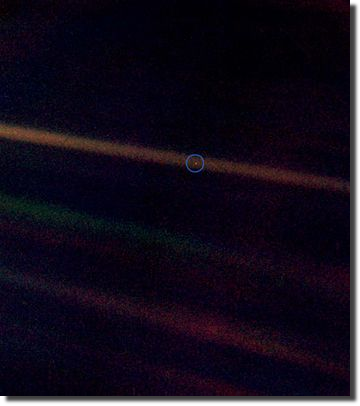
We're all in this together...
 |
| Seen from 6.4 billion kilometres away, Earth is a dot obscured in a beam of scattered sunlight (pinpointed by artificial blue circle). |
So here they are — a mosaic of squares laid down on top of the planets and a background smattering of more distant stars. We were able to photograph not only the Earth, but also five other of the Sun's nine known planets. Mercury, the innermost, was lost in the glare of the Sun, and Mars and Pluto were too small, too dimly lit, and/or too far away. Uranus and Neptune are so dim that to record their presence required long exposures; accordingly, their images were smeared because of spacecraft motion. This is how the planets would look to an alien spaceship approaching the Solar System after a long interstellar voyage.
From this distance the planets seem only points of light, smeared or unsmeared — even through the high-resolution telescope aboard Voyager. They are like the planets seen with the naked eye from the surface of the Earth — luminous dots, brighter than most of the stars. Over a period of months the Earth, like the other planets, would seem to move among the stars. You cannot tell merely by looking at one of these dots what it's like, what's on it, what its past has been, and whether, in this particular epoch, anyone lives there.
Because of the reflection of sunlight off the spacecraft, the Earth seems to be sitting in a beam of light, as if there were some special significance to this small world. But it's just an accident of geometry and optics. The Sun emits its radiation equitably in all directions. Had the picture been taken a little earlier or a little later, there would have been no sunbeam highlighting the Earth.
And why that cerulean color? The blue comes partly from the sea, partly from the sky. While water in a glass is transparent, It absorbs slightly more red light than blue. If you have tens of meters of the stuff or more, the red light is absorbed out and what gets reflected back to space is mainly blue. In the same way, a short line of sight through air seems perfectly transparent. Nevertheless — something Leonardo da Vinci excelled at portraying — the more distant the object, the bluer it seems. Why? Because the air scatters blue light around much better than it does red. So the bluish cast of this dot comes from its thick but transparent atmosphere and its deep oceans of liquid water. And the white? The Earth on an average day is about half covered with white water clouds.
We can explain the wan blueness of this little world because we know it well. Whether an alien scientist newly arrived at the outskirts of our solar system could reliably deduce oceans and clouds and a thickish atmosphere is less certain. Neptune, for instance, is blue, but chiefly for different reasons. From this distant vantage point, the Earth might not seem of any particular interest.
But for us, it's different. Look again at that dot. That's here. That's home. That's us. On it everyone you love, everyone you know, everyone you ever heard of, every human being who ever was, lived out their lives. The aggregate of our joy and suffering, thousands of confident religions, ideologies, and economic doctrines, every hunter and forager, every hero and coward, every creator and destroyer of civilization, ever king and peasant, every young couple in love, every mother and father, hopeful child, inventor and explorer, every teacher of morals, every corrupt politician, every "superstar," every "supreme leader," every saint and sinner in the history of our species lived there — on a mote of dust suspended in a sunbeam.
The Earth is a very small stage in a vast cosmic arena. Think of the rivers of blood spilled by all those generals and emperors so that, in glory and triumph, they could become momentary masters of a fraction of a dot. Think of the endless cruelties visited by the inhabitants of one corner of this pixel on the scarcely distinguishable inhabitants of some other corner, how frequent their misunderstandings, how eager they are to kill one another, how fervent their hatreds.
Our posturings, our imagined self-importance, the delusion that we have some privileged position in the Universe, are challenged by this point of pale light. Our planet is a lonely speck in the great enveloping cosmic dark. In our obscurity, in all this vastness, there is no hint that help will come from elsewhere to save us from ourselves.
The Earth is the only world known so far to harbor life. There is nowhere else, at least in the near future, to which our species could migrate. Visit, yes. Settle, not yet. Like it or not, for the moment the Earth is where we make our stand.
It has been said that astronomy is a humbling and character-building experience. There is perhaps no better demonstration of the folly of human conceits than this distant image of our tiny world. To me, it underscores our responsibility to deal more kindly with one another, and to preserve and cherish the pale blue dot, the only home we've ever known.
excerpt from Pale Blue DotChapter 1
Copyright © 1994 by Carl Sagan